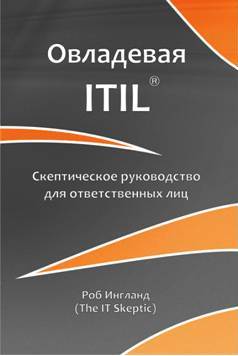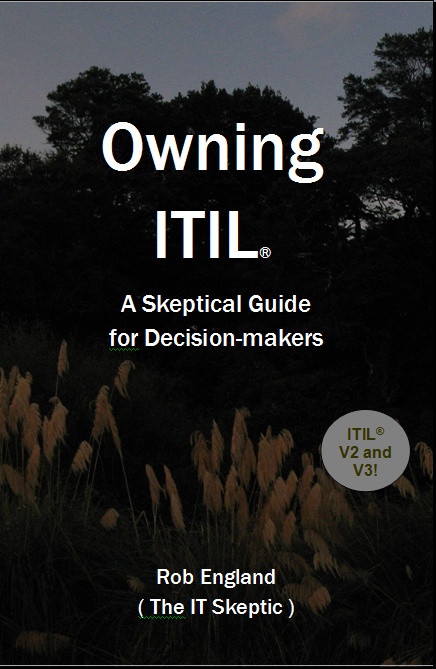The Skeptical Informer, January 2009, Volume 3, No. 1

The newsletter of the IT Skeptic. All the IT skeptical news that is fit to print... and then some!
- governance: which is hot in a serious way
- cloud computing: which is hot in an entirely vacuous vendor-hyped way
- alternatives to ITIL: which is not hot at all but I am predicting it will be
Features
ITIL started out as just the books, but it is much more today: it is a movement, a professional group, and an industry. A great deal of activity goes on in promotion and support of ITIL worldwide. Much of it is ungoverned and ad-hoc. There are many pillars of the house of ITIL and OGC governs and manages only four.
 The IT SwamiLate last night as I worked at my computer, I looked up at a sound in the normally quiet cul de sac that houses Two Hills World Headquarters Tower. From the back door of a police car tumbled the IT Swami, closely followed by his swag, which appeared to have been hurled rather than just fell. The police car then drove off while he picked himself up and examined himself for broken bones, or perhaps it was just some exotic late-night yoga - he does subscribe to strange practices.
The IT SwamiLate last night as I worked at my computer, I looked up at a sound in the normally quiet cul de sac that houses Two Hills World Headquarters Tower. From the back door of a police car tumbled the IT Swami, closely followed by his swag, which appeared to have been hurled rather than just fell. The police car then drove off while he picked himself up and examined himself for broken bones, or perhaps it was just some exotic late-night yoga - he does subscribe to strange practices.
In a familiar routine, I raced downstairs to hide the good whisky and cognac before he got to the doorbell. I slipped the smaller ornaments into a cupboard and put the kettle on. I knew he would need a coffee to sober him up.
Every year the IT Skeptic website starts the New Year with our Awards. (You can see last years' awards here).
|
|
Contents
The book is available NOW, from Amazon.com
After you read it, please give me feedback Owning ITIL was translated into Russian by Cleverics and may still be available from them.
 |
What readers are saying
Score: 10 out of 10... This is a wonderfully irreverent, but totally authoritative, book... It is a slim manual that seeks to debunk the language and meaning of ITIL and relate it to the practical implementation of IT service management... It’s a gem of a book that offers a good perspective on what the ITIL v3 manuals take 5 volumes to cover. BCS (British Computer Society) After reading it (twice), I realized what I had my hands on. This was a book for anyone just starting to research ITIL all the way to those of us who have been forced to drink the kool aid for a long time... I would highly recommend this book for EVERY IT and Management person today. Wish I had this two years ago Twitter comment from a reader Unbeatable. If you are interested in Service Management (if you are an IT professional, you should be), this book is a must. Enlightening, easy to read, loaded with experience and qualified opinions. The author puts the challenges, the hype, the misunderstandings and the real requirements on the table. You don't have to agree with the author in order to benefit (or enjoy) this book. Helge Skrivervik "Mellvik" It was a great pleasure to translate Rob’s book. He proved again that ‘talking seriously’ doesn’t necessarily mean ‘talking tediously’. And I’m sure that besides the pleasure the book brings real value from owning ITIL to a reader. Roman Jouravlev, translator of the Russian edition If you are feeling a bit giddy from ITIL training and over-dosing on ITIL PowerPoint slide decks, Owning ITIL provides the perfect antidote that will not only bring your ITIL transformation project down to earth but also greatly increase its likelihood of success. The Pros: Very easy to read and not too long. The references to other literature will help me through the minefield of complimentary guidance/opinions etc. I came across plenty of things I've done (both right & wrong) and potential mistakes that I might be able to avoid moving forward at work. Sometimes I had a wry smile, other times I has an "oh crap, we did that" moment. Just enough humour, while not being condescending or insincere (or maybe I have a thick skin). Some of the book is ageless (not so) common sense and some of the book is very current. Some of the current stuff will become out of date soonish but that's OK. The fundamental difference between the author's point of view and mine (reflected in this review) is that I don't see "ITIL... (becoming) something of a cult," or "a movement." I don't see ITIL becoming something it isn't. Quite simply, ITIL is documentation of good/best practice for IT. This doesn't lend itself to "cult" or anything else... Bottom line: The book author is The IT Skeptic. Read the book to understand a skeptical point of view. Don't accept it as your only guide to make competitive decisions to meet today's situations, challenges or demands. David Moskowitz Well I enjoyed it. If I have an issue it is that the horizon between Rob's most skeptical moments and his most practical real world comments aren't clearly distinguished. I THINK I know him well enough to detect the irony, but I'm never sure....and I think I know when when he is making a point knowing that the ensuing argument will further our mutual general understanding. James Finister Just finished reading "Owning ITIL", and thought it incredibly clarifying and brilliant in it's ability to cut to the quick. Thought it important enough to purchase 4 more copies for managers at our org to read. email to the author
|
Subscribe now
If you are not a subscriber already, click here to subscribe to have future editions of this newsletter emailed to you.
Get all the IT skeptical news that is fit to print ... and then some!
He Tangata
He aha te mea nui o te ao
What is the most important thing in the world?
He tangata, he tangata, he tangata
It is the people, it is the people, it is the people
Maori proverb
It is the people. IT is the people.
He Tangata has its own website now
From the blog
 [Hi! IF you came looking for insight into the rebounding world economy, you are looking for Dead Cat Bounce. This post is about IT project management. But thanks for dropping in! If you are interested in IT, please take a look around]
[Hi! IF you came looking for insight into the rebounding world economy, you are looking for Dead Cat Bounce. This post is about IT project management. But thanks for dropping in! If you are interested in IT, please take a look around]
Operational readiness of new and improved services ensures a smooth transition from Project to Production. ITIL talks about it in a number of places, but I think Operational Readiness needs to be recognised as a practice in its own right, like any other ITIL "process". OR is not (just) about being a gatekeeper to Prod: it's about ensuring readiness throughout the lifecycle. OR provides a positive benefit for the customers, projects, development, and operations.
[Updated May 2009] The CMDB Federation standards initiative must be the most over-hyped vendor marketing smokescreen ever. Whenever anyone raises the bogeyman of proprietary CMDBs, the vendors wheel this one out as the future promise of interoperability. It is pure vendor double-talk. It solves little and is taking forever to appear anyway. It solves little because the standard defines only how management tools can pass data between them- nothiong about what they pass. I bet the much-trumpeted demos seen so far involved data massaging and informal backroom agreements beyond that dictated by the standard in order to get it all to work. I am highly skeptical (surpise!) about the likelihood that this standard would enable or even faciltiate anything useful in a real-world implementation.
 Here is an amusing thing: all those diagrams of the Deming Cycle turn the wrong way.
Here is an amusing thing: all those diagrams of the Deming Cycle turn the wrong way.
Windows Vista makes the claim of "faster boot times". Faster than what? tectonics?
Bill the IT guy was fun in Episode 1. Here is Bill's next excellent adventure from Paglo, having a wee swipe at Apple Corp.
Delivery date for the COBIT User's Guide for Service Managers has slipped to "first quarter of 2009". (You may recall the IT Skeptic suggested this book will "put a cat amongst the ITIL pigeons").
While the IT Skeptic has been off playing with idle fripperies like Second Life, all sorts of exciting things have been happening quietly behind the scenes in Castle ITIL. It is time we caught up to date with developments. In particular, I wouldn't be doing ITIL V3 Foundation training right now.
Maybe I'll start collecting examples of terminological debasement, such as
In a recent announcement from APMG, the IT Skeptic identifies a troubling new terminological debasement trend. Apparently a committee is now a board. We had the Combined Strategy Board, the ITIL Qualifications Board. Now we have the Foundation Review Project Board. Come to think of it, ITIL has been doing this for a while: since when was a CAB anything but a committee?
It has come to my attention that somebody is claiming that ITIL Prime was one of the sites removed from this blog for copyright violation in their ITIL Foundation exam preparation questions. This is entirely untrue. If I find out who started this rumour I hope for the opportunity to discuss it with the perpetrator out back in a carpark. Not only is the allegation untrue but it is clearly false on two counts:
- we list only free sites - ITIL Prime is by subscription
- we clearly state the sites were subsequently taken down as a result of my complaint to their hosting company
Chokey the Chimp warns of a moderate Crap Factoid in the wild, with our old friends at BMC claiming a 370 percent ROI over 30 months on implementation of BMC's ITSM v7. One would struggle to swallow that kind of number from any business case, but given BMC's recent high-level bullshitting, Chokey definitely calls "CRAP!".
I wonder how the ITIL Live website is doing. And where they get their customers from.
Having recently become an author I am learning just how bloody hard it is. My humble efforts in no way compare to what the ITIL V3 authors produced. Although they had a lot more help than me, their products were much bigger, more complex, more closely scrutinised and of course much more significant.
[A guest post today from long-time reader Alison Adams with more feedback from the field on ITIL V3 exam questions:]
How confident are you in identifying the difference/s between a stated AIM, a PURPOSE, a GOAL and an OBJECTIVE ?
A dictionary might not help much, look them up in dictionary.com, they reference one another in a complete circle. Even the official ITIL glossary includes -
"Objective: the defined purpose or aim of a Process and Activity or an Organisation….."
I see a lot of fiddling while the economy burns. In fact there appears to be an air of "phew that's over". The recession drops off the media's radar thanks to their infantile attention spans. Please be aware that this recession hasn't even started - and plan your coming years accordingly.
We traditionally define what constitutes a CI in terms of Change Management but are there better ways?
I'm sure I'm not the first to reflect on the evil genius of .docx document format but I feel the need to vent a little spleen. Only the Evil Empire of MickeySoft could be this twisted.
The ITSM community should ponder this for two reasons: (1) just how much do we trust Microsoft's 'free' MOF 4.0? (2) ITIL's inability to play nicely with COBIT or other de-facto standards might result in eventual convergence or it might not - watch the scrap between OOXML and ODF for clues.
Is the itSMF International website adrift again?
I remember seeing an Aussie comedy TV show once (The Games as I recall?) where it suggested that a public statement by the Prime Minister that "So-and-so has our full support" meant they would be out within days. This memory came to me as I wondered why it was necessary for Keith Aldis, CEO itSMF, to come out with a press release to tell the world that “Real progress is being made in the development and implementation of ITIL V3 qualifications". A year and a half after go-live one would bloody hope so.
When we want to know how to, say, measure a service desk, we can find quite exact guidance everywhere. But it seems to me the depth and specificity (specifity? specificness?) and usefulness of advice is inversely proportional to the importance of the question. Consider the most important question we need answered in a service management initiative.
As we said before, Real ITSM does things differently to, say, ITIL. Readers may recall that Real Priority (also known as Care Factor) is measured by the number of metaphorical fans that are being hit by effluent: it starts at zero and goes up. More conventionally, Real ITSM also tracks a separate User Priority (also known as the Dummy Factor, for the number of dummies being spat).
Please forward this newsletter to someone who would enjoy it
Subscribe | Blog |  Blog RSS |
Blog RSS |  Podcast RSS | Feedback
Podcast RSS | Feedback
© Copyright 2006-2009 Two Hills Ltd www.twohills.co.nz. All rights reserved
Permission is required to reproduce this content in any form. Brief extracts may be used without permission if attributed with a link to the site.
"The IT Skeptic™", "The Skeptical Informer™", "The IT Swami™", "Chokey the Chimp™" and "BOKKED™" are trademarks of Two Hills Ltd.
ITIL® is a Registered Trade Mark and a Registered Community Trade Mark of the UK Office of Government Commerce ("OGC"). ITIL® is registered in the U.S. Patent and Trademark Office.
COBIT® is a Registered Trade Mark of the Information Systems Audit and Control Association and the IT Governance Institute.
Microsoft® is a Registered Trade Mark of Microsoft Corp. in the United States and/or other countries.
CMM® is a Registered Trade Mark of Carnegie Mellon University.
ISO® is a Registered Trade Mark of the International Organisation for Standardisation.
This newsletter and its contents are neither associated with nor endorsed by the OGC or any other organisation.
The contents of this newsletter do not represent the views of Two Hills Ltd.






 Made in New Zealand
Made in New Zealand 
